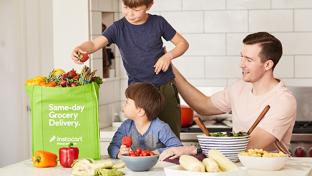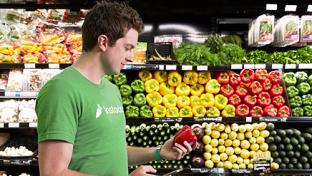Curbing Friction With Pickup
When Instacart’s VP of retail, Chris Rogers, talks to retailers in need of e-commerce help, the first thing he tells them is that there’s no one-size-fits-all solution. The second thing he tells them is that doing online grocery is really, really hard.
“I tell them doing e-commerce well is difficult,” affirms Rogers, who worked at Procter & Gamble and more than a decade at Apple before joining Instacart in 2019. “I believe grocers are understanding that: Getting the shop, the delivery and the pickup all right is not easy. The attention to detail takes years to get right. And we’ve invested a lot in this part of the business to make it look seamless.”
Rogers spends a lot of time in conference rooms helping retailers solve e-commerce problems, from creating turnkey white-label apps, to building an entire customized digital end-to-end ecosystem, to expanding their online assortment, to talking to legislators in each state to help bring something like alcohol delivery to life, to designing parking spots for grocery pickup. Today, out of the San Francisco-based company’s 400 retail partners, 175-plus have partnered with Instacart to digitize their catalogs, to create their online storefronts, or, in many cases, just to build their entire e-commerce end-to-end capabilities.
DISCOVER MORE ON INSTACART
- The Predictable Rise: A suddenly essential service envisions grocery's digital future.
- Algorithms for Avocados: Instacart's technology serves to delight the customer.
“All of these initiatives drive growth for our retail partners, but they also help differentiate them and bring a true omnichannel experience to life online,” Rogers says.
Lately, during the pandemic, the dominant topic of conversation for Rogers and retailers has been grocery pickup, which has been exploding during the pandemic.
“There is very, very strong demand both on the retailer side and the consumer side for pickup,” Rogers notes. “It’s been interesting, because we’ve been enabling our partners with technology to do the pickup themselves.”
One example of this is Lakeland, Florida-based Publix Super Markets, which offers grocery pickup, but uses a combination of Instacart shoppers and Publix employees to fulfill pickup orders. An Instacart shopper picks and stages the order, and a Publix employee takes the order out to the customer waiting in her car.
“Ninety-nine percent of our pickup stores are a curbside experience,” says Sarah Mastrorocco, general manager of the pickup program at Instacart. “COVID has forever changed the way people shop for groceries. The one thing that differentiates curbside from a delivery experience is it is more economical — the fees are less. So I think pickup makes sense for a lot more people post-COVID and in the future, because it is much more of a value play versus delivery.”
Since March, Instacart has brought pickup online in more than 1,500 locations, doubling its pickup footprint since 2018 to 3,000 stores. Mastrorocco says that the company is seeing consumers “put more items in their baskets overall, relative to delivery.” According to the company, its pickup program has been so successful because it’s leveraging a “deep partnership” approach to working with food retailers.
“We are supporting our retailers behind the scenes,” she says. “We work with them weekly and ask them, ‘How are your sales growing? Which stores are underperforming? Do we have the right staffing? What do we predict the demand will be? What happens if there isn’t an open window? How can we make sure that you’re driving quality? Quality is going to retain customers. And how do we make sure that we’re doing it efficiently so we can all save money and maximize our profits in the long run?”










